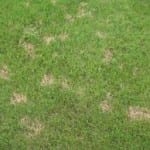The fungus,Sclerotinia homoeocarpa is responsible for dollar spot. The fungus lays dormant over the winter, resting in the grass blade's stomata, a membrane within the grass blade. Dollar spot flourishes in 60 & 85 degree daytime temperatures and when the grass is wet for a long period of time. Therefore, hot, humid or wet days are prime conditions for this lawn disease to pop up.

How do you spot dollar spot?
Like all grass diseases, dollar spot starts small a homeowner won't notice dollar spot symptoms until it starts to spread in its characteristic outward, circular pattern. Dollar spot symptoms include:
- Small yellow spots on individual grass blades
- A straw-colored or tan band with dark edges starts to spread across individual grass blades
- The band grows to look more like an hour glass on the grass blade
- And the grass blade eventually turns completely white, and the disease will continue to spread throughout your yard.
What can you do about preventing dollar spot on your yard?
Extensive dollar spot development in residential lawns should be treated. Under most cases dollar spot arises when a lawn is nitrogen deficient. Following a simple year-round program for nitrogen fertility can help prevent the disease. Regular mowing to a height of about 3 inches will improve turf recovery.
